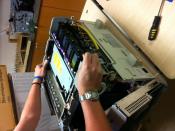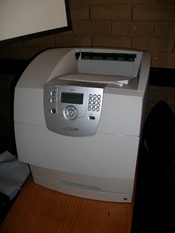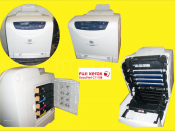A page description language communicates the image to be printed. The first thing the printer does, is convert the instructions into a bitmap, which is done by its internal processor. An image (in memory), is the result, of which every dot will be placed on the paper. Models designated to be "Windows printers" don't have their own processors. Because of this, the host PC creates bitmap, which writes it directly to the printer's memory. In the center of the laser printer there is a small rotating drum, called the organic photo-conducting cartridge. It has a coating that allows it to hold an electrostatic charge. To begin with the drum is given a total positive charge. Subsequently, a laser beam scans across the surface of the drum, selectively imparting points of negative charge onto the drum's surface that will ultimately represent the output image. The area of the drum is the same as the area of the paper that the picture will go onto, every point on the drum corresponds to a point on the sheet of paper.
Next, the paper is passed through an electrically charged wire, which gives it a negative charge.
On accurate laser printers, turning the laser on and off as it scans the rotating drum, and using a complex arrangement of spinning mirrors and lenses does the selective charging. The theory is the same as the theory of a disco mirror ball. The lights bounce from the ball to the floor, trail across the floor and disappear as the ball turns. In a laser printer, the mirror drum rotates incredibly quickly and is synchronized with the laser switching on and off. A typical laser printer will perform millions of switches, every second. The drum rotates, inside the printer, to build one horizontal line at a...



Interesting
this is an interesting paper...ill remember it next time im printing out a paper
1 out of 1 people found this comment useful.